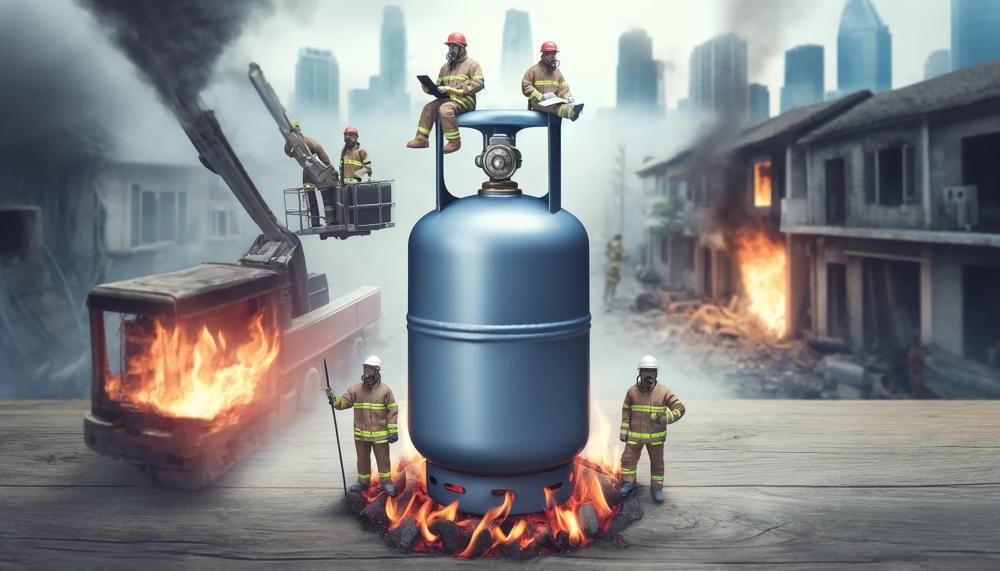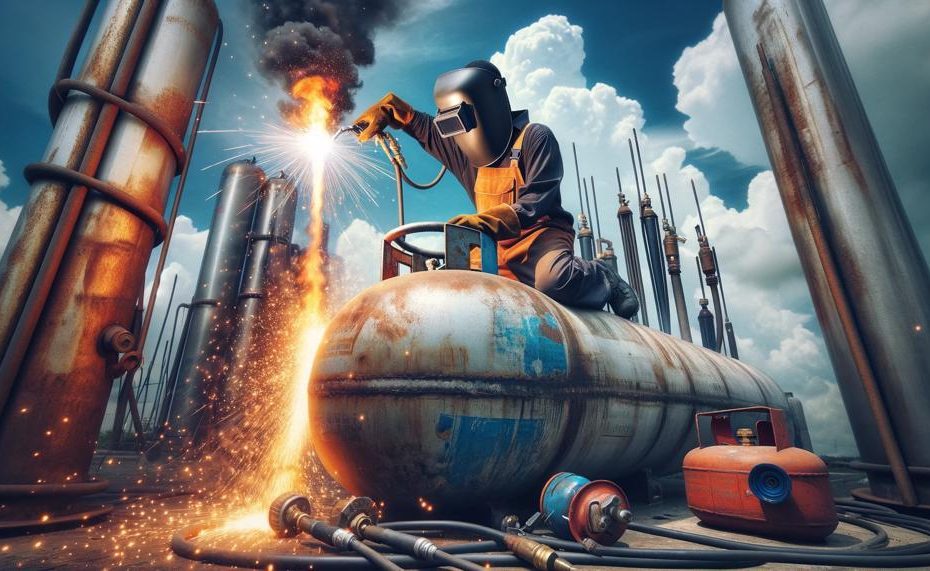Welding projects often call for a blend of skill, precision, and safety, especially when it comes to handling fuel tanks. If you’re diving into a task that involves a propane tank, ensuring it’s safely emptied is crucial before you begin. This isn’t just about following protocol; it’s about safeguarding your workspace, your project, and most importantly, yourself. In this comprehensive guide, we’ll navigate through the steps and precautions necessary to prepare a propane tank for welding, ensuring you tackle your project with confidence and safety.
So, how to safely empty a propane tank for welding?
As long as you don’t damage anything, you can take off the valve, fill the tank with water, and then drain it. You could also do these things:
- Take the valve off.
- Put hot water in the tank.
- Move around
- Empty the tank.
- Do steps 6 through 8 again.
- In order to join, fill the tank with a harmless gas.
You can either use the gas for something else or take the tank to a propane store or an approved collection place to get rid of it.
By merging expert advice with practical steps, our goal is to empower you with the knowledge you need to safely prep your propane tank for welding. Whether you’re a seasoned welder or a curious DIY enthusiast, this guide will provide valuable insights to enhance your welding practices.
Contents
- 1 How to Purge a Propane Tank for Welding
- 2 Disconnecting And Preparing The Propane Tank
- 3 Releasing Gas Safely In An Open Space
- 4 Double-Checking For Gas Remnants
- 5 Closing The Valve And Preparing For Welding
- 6 Cutting Off The Top Of The Tank
- 7 Checking For Remaining Gas And Ensuring Safety
- 8 Releasing Gas Safely In An Open Space
- 9 Double-Checking For Gas Remnants
- 10 Closing The Valve And Preparing For Welding
- 11 Cutting Off The Top Of The Tank
- 12 Checking For Remaining Gas And Ensuring Safety
- 13 Conclusion
How to Purge a Propane Tank for Welding
When purging a propane tank for welding, ensuring your safety and that of those around you is paramount. The steps below are outlined to guide you through this process with the utmost caution:
| Step | Action | Details |
| 1 | Disconnect Attachments | Ensure all hose attachments are removed and the valve is securely closed. |
| 2 | Move to an Open Area | Relocate the tank to a spacious, open area, far from people and flammable materials. |
| 3 | Tilt and Release Gas | Angle the tank so the valve points downwards, allowing any residual gas to escape. |
| 4 | Verify Gas Elimination | Attach the tank to a grill and attempt to light it to check for any lingering gas. |
| 5 | Cut the Top Off | With the valve shut, slice off the tank’s top, ensuring your cutting tool is suitable for the job. |
| 6 | Listen for Gas | Reopen the valve momentarily to listen for the sound of escaping gas, indicating more purging is needed. |
| 7 | Wear Protective Gear | Always don protective gloves, goggles, and a respiratory mask to shield yourself from harm. |
| 8 | Clean and Fill | Post-purging, cleanse the tank with a non-flammable solvent, then fill with an inert gas like argon or nitrogen to ensure an oxygen-free environment for welding. |
| 9 | Keep Distance | Maintain a safe distance between the welding area and the propane tank, guaranteeing ample ventilation and adherence to safety guidelines. |
Remember, safety is not just a guideline but a responsibility. Ensure you’re wearing the correct gear, working in a well-ventilated space, and rigorously following these steps to minimize any risks.
Disconnecting And Preparing The Propane Tank
To safely disconnect and prepare a propane tank for welding, follow these essential steps, ensuring each action is performed with care and attention to detail. Safety gear is paramount, including gloves, goggles, and a respiratory mask, to protect against any unforeseen mishaps.
Safety Gear and Precautions:
- Gloves: To shield hands from cold metal and potential leaks.
- Goggles: To protect eyes from harmful gases.
- Respiratory Masks: To prevent inhalation of any hazardous fumes.
Step-by-Step Guide:
| Step | Action | Details |
| 1 | Check Ventilation | Ensure the work area is airy, reducing risk of gas accumulation. |
| 2 | Secure Ignition Sources | Switch off anything that could ignite the propane. |
| 3 | Disconnect Valve | Use the right tools to detach the tank valve, letting all gas escape safely. |
| 4 | Leak Inspection | Examine both tanks and regulators for any potential leaks. |
| 5 | Select Proper Equipment | Opt for devices specifically designed for propane. |
| 6 | Safe Propane Disposal | When burning off from small tanks, do it in a ventilated area and secure the tank firmly. |
| 7 | Use Transfer Pump Wisely | While transferring propane, wear safety gear and keep an eye on the tank’s pressure. |
| 8 | Prohibit Propane Venting | Avoid releasing propane into the environment. |
Remember, the aim is not just to prepare the tank for welding but to do so without causing harm to yourself, others, or the environment. Each step, from ensuring good ventilation to carefully selecting and using appropriate equipment, plays a crucial role in mitigating risks.
Releasing Gas Safely In An Open Space
To safely release gas from a propane tank in an open space, specifically for welding purposes, adhere to the outlined steps below. This ensures both safety and efficiency, mitigating potential hazards.
Step-by-Step Guide:
| Step | Action | Reason and Safety Tips |
| 1 | Disconnect Hoses | Halts gas flow. Ensure the valve is fully closed to avoid leaks. |
| 2 | Choose a Safe Location | Opt for an open area, distant from flammable materials and ignition sources. |
| 3 | Release Gas | Position tank sideways with valve down. Slowly open to vent gas safely. |
| 4 | Check for Residual Gas | Connect to a grill, ignite briefly to ensure tank is empty. Prevents welding accidents. |
| 5 | Seal the Valve | Tighten valve post-gas release. Secures tank against inadvertent gas escape. |
| 6 | Prepare for Welding | Cut top with valve closed. Allows internal inspection and cleaning. |
| 7 | Final Gas Check | Reopen valve, listen for gas. Ensures complete evacuation before welding. |
Safety Enhancements:
- Purging: Replace oxygen inside the tank with an inert gas, such as argon, to avert explosions. This step is pivotal for tanks subjected to welding heat.
- Protective Gear: Always don protective equipment, such as gloves and safety glasses. Safety is paramount.
- Ventilation: Ensure the chosen space is well-ventilated. Adequate air circulation is crucial for dispersing gas safely.
- Follow DOT Guidelines: Only vapor, not liquid propane, should be released as per DOT regulations. This minimizes risk.
- Expert Protocols: Adhering to recommended safety procedures, such as solvent cleaning or inert gas flushing, fortifies safety.
By meticulously following these guidelines, the task of releasing gas from a propane tank for welding becomes both safe and effective.
Double-Checking For Gas Remnants
When you’re gearing up to make a propane tank safe for welding, the task at hand isn’t just about emptying it; it’s about ensuring every last whiff of gas is gone. Here’s the crux of doing it right, with a focus on safety every step of the way:
| Step | Action | Why It Matters |
| 1 | Disconnect and Seal | Prevents gas escape and accidents. |
| 2 | Head Outdoors | Reduces ignition risks in a well-ventilated area. |
| 3 | Grill Test | A practical way to check for gas remnants. |
| 4 | Repeat Purging | Ensures tank is completely gas-free. |
| 5 | Secure Valve | Avoids leaks and potential accidents. |
| 6 | Protective Gear | Essential for personal safety. |
| 7 | Use Proper Tools | Ensures a safe and effective process. |
| 8 | Stay Alert | Keeping safety in mind at all times. |
Remember, it’s not just about getting the job done; it’s about doing it safely. Every step is a crucial link in the chain of safety, and skipping even one could lead to a dangerous outcome.
Closing The Valve And Preparing For Welding
To properly close the valve and ready a propane tank for welding, a meticulous approach is needed. This not only ensures the safety of the individual performing the welding but also safeguards the surroundings. The guidance below, distilled from practical wisdom and industry standards, aims to provide clarity on this matter.
- Donning Safety Apparel: Begin by suiting up in the essential safety attire. This includes gloves to protect your hands, goggles to shield your eyes, and a respiratory mask to prevent inhalation of any harmful gases.
- Ventilation is Key: Confirm the area is airy enough to dispel any lingering propane gas, minimizing the risk of combustion.
- Extinguish Ignition Sources: A fundamental step is to eliminate any potential ignition sources in the vicinity, ensuring a spark-free environment.
- Disconnecting and Emptying the Tank: Employ the correct tools and follow established procedures to detach and then exhaust the tank of its contents.
- Leak Examination: Prior to initiating welding work, meticulously inspect the tank and its regulators for any leaks.
- Opt for Appropriate Equipment: Select tools and equipment that are specifically designed for handling propane to ensure safety and efficiency.
- Safe Burn-off for Small Tanks: If dealing with smaller tanks, conduct any burn-off in a spacious, well-ventilated setting, far removed from combustible materials or sparks.
- Transfer Pump Precautions for Larger Tanks: Utilize the correct fittings and closely monitor the pressure to avert tank rupture when transferring propane using a pump.
- Ethical Gas Disposal: Finally, dispose of any residual gas in a manner that does not harm the environment, avoiding direct release into the atmosphere.
Cutting Off The Top Of The Tank
To safely cut off the top of a propane tank for welding, it’s essential to approach the task with a mix of caution, proper technique, and the right safety measures. Here’s a distilled guide to keep you right and tight throughout the process:
| Step | Action | Importance |
| Disconnect and Close | Remove attachments, close valve. | Prevents accidental gas flow. |
| Move and Tilt | Shift to open space, tilt for gas release. | Safety measure to avoid gas build-up. |
| Gas Check and Purge | Use grill to check, repeat purge if necessary. | Ensures tank is gas-free before cutting. |
| Cutting with Care | Valve closed, wear safety gear. | Maintains safety while cutting. |
| Final Check | Listen for gas, repeat purge if detected. | Confirms the absence of gas post-cutting. |

Following these steps with a watchful eye and a steady hand will guide you through safely cutting off the top of a propane tank for welding.
Checking For Remaining Gas And Ensuring Safety
To suss out remaining gas in a propane tank and ensure its safe depletion for welding tasks, you’d do well to heed the following directives. Let’s cut to the chase, armed with a blend of simplicity and the necessary know-how.
| Step | Action | Reason |
| 1 | Wear Protective Gear | Prevents personal injury during the process. |
| 2 | Check Ventilation | Reduces risk of gas accumulation and potential explosion. |
| 3 | Turn Off Ignition Sources | Avoids triggering a fire or explosion. |
| 4 | Disconnect Tank Valve | Prepares the tank for safe gas removal. |
| 5 | Purge Gas | Removes residual gas safely. |
| 6 | Check for Leaks | Ensures there are no escape routes for gas, enhancing safety. |
Releasing Gas Safely In An Open Space
Releasing gas from a propane tank into an open space for welding purposes demands a blend of caution, knowledge, and adherence to safety protocols to thwart any mishap.
Step-by-Step Precautions:
| Step | Action | Rationale |
| 1 | Wear safety gear | Protects against unexpected sparks or debris. |
| 2 | Ensure area is well-ventilated and clear of hazards | Minimizes the risk of gas accumulation and potential ignition. |
| 3 | Disconnect hose attachments and tightly close the valve | Prevents accidental gas release. |
| 4 | Tilt tank sideways, valve facing down | Ensures gas is released safely without pressure build-up. |
| 5 | Ignite any residual gas in a controlled manner | Confirms absence of gas, reducing explosion risk. |
| 6 | Cut the tank with the valve closed, using proper tools | Prevents accidental gas release during welding. |
| 7 | Check for escaping gas after reopening the valve | Ensures all gas has been safely released. |
Double-Checking For Gas Remnants
To guarantee your propane tank is utterly devoid of any lingering gas traces before you embark on welding, a meticulous procedure must be adhered to.
Venting the Gas
- Preparation: Don your safety gear—gloves and goggles are a must. Make sure you’re in a spot that’s well-aired, far from any sparks or flames. This step’s crucial for keeping things safe.
- Positioning: Lay the tank so its valve faces sideways. This bit’s about ensuring every last hiss of gas finds its way out.
- Release: Twist that valve open, stand back, and let the tank do its thing. You’re aiming for a complete gas exodus. Shut the valve once you’re convinced it’s empty.
Safety Measures
| Protective Gear | Distance from Flames | Environment |
| Gloves and goggles | Keep a clear 10-foot radius | Opt for outdoor or well-ventilated spaces |
| Check for leaks | Use a soapy water solution | Apply around the valve and look for bubbles |
Disposal and Recycling
- Eco-friendly Tip: Don’t chuck your tank into the abyss. That’s bad for our planet. Instead, swap it at an RV park or a campsite. They know what to do.
- Big Tanks: Got a beast of a tank? Call in the pros. Dealers have the know-how for safe disposal.
Closing The Valve And Preparing For Welding
To safely close the valve and prep a propane tank for a bit of welding action, here’s a step-by-step that’ll keep things tidy and hazard-free. It’s all about ensuring not a whisper of propane lingers before sparks fly. Here’s how you do it, keeping it simple and straight, without any of that overly formal chatter.
| Step | Action | Details |
| 1 | Kit Up | Slip on your gloves, goggles, and mask to keep the nasties at bay. |
| 2 | Clear the Air | Make sure your workspace is breezy to stop gas from gathering. |
| 3 | Switch Off Ignition Sources | Anything that can spark? Turn it off, disconnect it, or move it far away. |
| 4 | Valve Shut-Down | Use your trusty wrench to twist that valve tight and secure. |
| 5 | Regulator Detachment | Another twist of the wrench, and the regulator’s off, no sweat. |
| 6 | Gas Check | Burn off any lingering gas carefully, in a spot where it’s safe to do so. |
| 7 | Leak Hunt | Slather soapy water around connections. Bubbles? Tighten up those spots. |
| 8 | Sniff Out Trouble | With a gas detector in hand, confirm there’s no propane hiding out. |
| 9 | Emptying Strategy | Small tank? Burn off. Big boy? Transfer pump’s your friend. |
| 10 | Transfer Pump Precautions | Ensure it’s for propane and can handle the pressure. Keep a fire extinguisher ready. |
| 11 | Monitor Pressure | Keep an eye on the pressure gauge; don’t let it creep too high. |
| 12 | Proper Disposal | Don’t just vent it. Dispose of gas respectfully of ol’ Mother Nature. |
Remember, it’s not about racing through these steps. It’s about doing it right, so you’re safe and sound, ready to weld without a care in the world.
Cutting Off The Top Of The Tank
When tackling the task of severing the top off a propane tank for welding, arm yourself with the right kit and heed safety measures to sidestep any misadventure. Here’s a straightforward guide, making sure you’re clued up and cloaked in the necessary gear.
Tools and Safety Kit for the Job:
| Tool/Equipment | Usage | Safety Feature |
| Appropriate cutting tools (e.g., angle grinder, plasma cutter) | For cutting the tank | Ensures precision and reduces risk of sparking |
| Personal Protective Equipment (PPE): Gloves, Goggles, Face Mask | Personal safety while cutting | Shields against sparks, debris, and hazardous fumes |
| Inert Gas (Argon or Nitrogen) | To fill the tank before welding | Prevents combustion by displacing oxygen |
Vital Safety Precautions:
- Valve Vigilance: Before diving into the task, ensure the valve is shut tight to prevent any gas escape.
- Open Space Operations: Opt for an airy locale, far from potential peril, to undertake your work.
- Protective Gear is Paramount: Don your PPE without fail to fend off flying debris or sparks.
- Gas Check: Hook the tank up to a grill and light it to double-check for lingering gas. Should you detect any remnants, purge again.
- Clean-Up: Employ a non-flammable solvent for cleansing followed by a double water flush to expunge any residual gas.
- Inert Gas Fill-Up: Prior to welding, fill the tank with an inert gas like argon or nitrogen, creating a safe environment by ousting oxygen.
- Steer Clear of Proximity Perils: Keep the welding action distanced from propane tanks to avoid the risk of explosions or fires.
Remember, the key to a successful cut is not just in wielding the right tools but in adhering to these safety steps religiously.
Checking For Remaining Gas And Ensuring Safety
To ensure a propane tank is properly emptied for welding and made safe for use, one must meticulously follow a sequence of steps aimed at averting any potential hazards. Here’s a guide that keeps safety at the forefront:
| Step | Action | Reason |
| Protective Gear | Wear gloves, goggles, and a mask. | Personal safety. |
| Ventilation | Ensure good airflow. | Prevents gas accumulation. |
| Ignition Sources | Turn off all sources. | Avoids fire/explosion. |
| Proper Tools | Use specific tools and methods. | Efficiency and safety. |
| Leak Checks | Inspect tanks and regulators. | Prevents accidents. |
| Right Equipment | Choose propane-rated gear. | Appropriate for the task. |
| Safe Disposal | Do not vent gas. | Environmental protection. |
By following these steps, one not only ensures the propane tank is ready for welding but also upholds the highest safety standards.
Conclusion
Adopting the complicated dance of welding, especially when it comes to gas tanks, requires strict attention to safety and planning.
Before using the welding torch, making sure that the propane tank is completely empty of any gas that might still be in it is a very careful process. Every action, from the first step of taking off attachments and going to a clear area to the careful process of gas draining and cutting, shows a strong dedication to safety.
Putting on protective gear will always be there for you in case something goes wrong, and filling the tank with a harmless gas like argon shows how carefully you need to make the area safe for welding. There are several important steps in the process of safely emptying a gas tank for welding. Each one is necessary to make sure your job is safe.
Every step and safety measure fits into a perfect symphony, with the main goal of making sure there are no dangers in the workplace.





